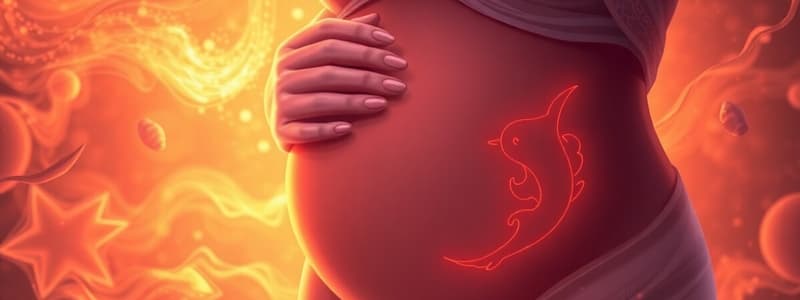Podcast
Questions and Answers
What hormonal change occurs as part of the process leading to labor?
What hormonal change occurs as part of the process leading to labor?
- Increase in fetal cortisol
- Decrease in progesterone (correct)
- Increase in progesterone
- Decrease in estrogen
Which hormone is released in response to the decrease in progesterone during labor?
Which hormone is released in response to the decrease in progesterone during labor?
- Oxytocin (correct)
- Estrogen
- Prolactin
- Luteinizing hormone
What mechanical factor contributes to the initiation of labor?
What mechanical factor contributes to the initiation of labor?
- Expansion of the cervix
- Over stretching of the uterus (correct)
- Contraction of the diaphragm
- Increased fetal movement
What roles do prostaglandins play in the labor process?
What roles do prostaglandins play in the labor process?
Which of the following hormones increases in relation to progesterone as labor approaches?
Which of the following hormones increases in relation to progesterone as labor approaches?
What effect do myometrial contractions have on sympathetic nerves?
What effect do myometrial contractions have on sympathetic nerves?
What is the role of oxytocin in relation to myometrial receptors?
What is the role of oxytocin in relation to myometrial receptors?
Which of the following statements is true regarding oxytocin release?
Which of the following statements is true regarding oxytocin release?
When oxytocin binds to its receptors, what is the resulting activity in the myometrium?
When oxytocin binds to its receptors, what is the resulting activity in the myometrium?
How does sympathetic nerve activation affect the relationship between myometrial contractions and oxytocin?
How does sympathetic nerve activation affect the relationship between myometrial contractions and oxytocin?
What is the duration of the fourth stage of labor?
What is the duration of the fourth stage of labor?
What should be monitored during the fourth stage of labor?
What should be monitored during the fourth stage of labor?
Which factors can influence the length of labor?
Which factors can influence the length of labor?
What happens to the muscle fibers during contraction according to the provided information?
What happens to the muscle fibers during contraction according to the provided information?
What follows the fourth stage of labor?
What follows the fourth stage of labor?
How does the upper uterine segment change during the contraction process?
How does the upper uterine segment change during the contraction process?
What can be inferred about the muscle fibers' behavior during the contraction process?
What can be inferred about the muscle fibers' behavior during the contraction process?
What is the key reason for monitoring the mother and fetus during the fourth stage of labor?
What is the key reason for monitoring the mother and fetus during the fourth stage of labor?
What effect does the contraction have on the upper uterine segment's capacity?
What effect does the contraction have on the upper uterine segment's capacity?
Which of the following statements about muscle fibers during contraction is true?
Which of the following statements about muscle fibers during contraction is true?
What does crowning refer to in the second stage of labor?
What does crowning refer to in the second stage of labor?
How long can the second stage of labor last for a primigravida (first-time mother)?
How long can the second stage of labor last for a primigravida (first-time mother)?
Which of the following is NOT a sign associated with the second stage of labor?
Which of the following is NOT a sign associated with the second stage of labor?
Which factor is likely to influence the duration of the second stage of labor?
Which factor is likely to influence the duration of the second stage of labor?
What is a common occurrence alongside the everted anus during the second stage of labor?
What is a common occurrence alongside the everted anus during the second stage of labor?
What characterizes true labor contractions?
What characterizes true labor contractions?
Which of the following is true about false labor pain?
Which of the following is true about false labor pain?
What is the relationship between true labor and the membranes?
What is the relationship between true labor and the membranes?
How does true labor pain respond to sedation?
How does true labor pain respond to sedation?
Which aspect is essential in care during the first stage of labor?
Which aspect is essential in care during the first stage of labor?
Flashcards
Progesterone decrease
Progesterone decrease
A decline in the hormone progesterone levels.
Oxytocin release
Oxytocin release
The release of oxytocin, a hormone that stimulates contractions.
Estrogen increase
Estrogen increase
An increase in estrogen levels relative to progesterone.
Fetal cortisol release
Fetal cortisol release
Signup and view all the flashcards
Uterine stretching
Uterine stretching
Signup and view all the flashcards
Sympathetic nerve activation
Sympathetic nerve activation
Signup and view all the flashcards
Oxytocin receptors
Oxytocin receptors
Signup and view all the flashcards
Oxytocin binding
Oxytocin binding
Signup and view all the flashcards
Oxytocin's role in labor
Oxytocin's role in labor
Signup and view all the flashcards
Myometrium
Myometrium
Signup and view all the flashcards
Incomplete Relaxation of Uterine Muscles
Incomplete Relaxation of Uterine Muscles
Signup and view all the flashcards
Upper Uterine Segment Changes
Upper Uterine Segment Changes
Signup and view all the flashcards
Reduced Uterine Capacity
Reduced Uterine Capacity
Signup and view all the flashcards
Uterine Changes and Labor Force
Uterine Changes and Labor Force
Signup and view all the flashcards
Uterine Changes and Labor
Uterine Changes and Labor
Signup and view all the flashcards
Fourth Stage of Labor
Fourth Stage of Labor
Signup and view all the flashcards
Parity
Parity
Signup and view all the flashcards
Birth Interval
Birth Interval
Signup and view all the flashcards
Factors Affecting Labor Length
Factors Affecting Labor Length
Signup and view all the flashcards
Postpartum Unit
Postpartum Unit
Signup and view all the flashcards
What is the second stage of labor?
What is the second stage of labor?
Signup and view all the flashcards
What is the perineum, and why does it bulge during labor?
What is the perineum, and why does it bulge during labor?
Signup and view all the flashcards
Why does the anus sometimes turn outwards during labor?
Why does the anus sometimes turn outwards during labor?
Signup and view all the flashcards
Why might the vaginal opening be slightly open during labor?
Why might the vaginal opening be slightly open during labor?
Signup and view all the flashcards
What is crowning in labor?
What is crowning in labor?
Signup and view all the flashcards
What is a key feature of true labor contractions?
What is a key feature of true labor contractions?
Signup and view all the flashcards
What happens to the cervix during true labor?
What happens to the cervix during true labor?
Signup and view all the flashcards
How do false labor contractions differ from true labor contractions?
How do false labor contractions differ from true labor contractions?
Signup and view all the flashcards
How do false labor contractions respond to relaxation?
How do false labor contractions respond to relaxation?
Signup and view all the flashcards
How do true labor contractions respond to pain relief?
How do true labor contractions respond to pain relief?
Signup and view all the flashcards
Study Notes
Labour Process
- Labour is the process where the fetus, placenta, and membranes are expelled through the birth canal after 24 weeks of pregnancy, facilitated by regular uterine contractions.
- This process leads to progressive effacement and dilation of the cervix.
Cervical Dilation
- Cervical dilation is the widening and stretching of the cervix beyond its normal dimensions.
- Measured in centimeters (0-10cm).
Cervical Effacement
- Cervical effacement involves softening, thinning, and shortening of the cervix.
- Expressed as a percentage (0-100%).
Stages of Labour
- There are four stages of labor.
First Stage
- Begins with the onset of true labor and continues until complete cervical dilation (from 0cm to 10cm).
- Latent Phase: Dilation from 0-3 cm. Mild, regular contractions.
- Active Phase: Dilation from 4-7 cm. 5-8 minutes apart, Moderate-Strong contractions lasting 45-60 seconds.
- Transitional Phase: Dilation from 8-10 cm. Strong contractions, 1-2 minutes apart, lasting 60-90 seconds.
Second Stage
- Begins when the cervix is fully dilated and ends with the birth of the baby.
- Signs include an urge to push, bulging of the perineum, possibly expulsion of stool, and an open vaginal introitus.
- Crowning occurs when the infant's head is visible at the vaginal opening.
- Duration varies, potentially 1-3 hours.
Third Stage
- Begins after the birth of the baby and ends with the delivery of the placenta and membranes.
- Usually takes 5-30 minutes.
- Signs of placental separation include lengthening of the umbilical cord, a sudden gush of blood, and a change in the uterus shape to a hard, globular form at the umbilicus.
Fourth Stage
- Post-delivery, lasts approximately 1 hour, focusing on monitoring the mother and baby for any complications. The mother is moved to the post-partum unit.
Factors Affecting Labor Length
- Parity (number of previous pregnancies)
- Birth interval (time between births)
- Psychological status
- Maternal pelvic shape
- Presentation (position of the fetus)
- Contractions
- Fetus position
The Passenger
- Fetus, umbilical cord, and the placenta.
- The fetal head is the widest diameter and crucial for delivery.
- The fetal skull is comprised of 8 bones connected by suture lines allowing for molding during birth.
- Fontanels, soft spots on the skull, help determine the position of the fetus during labor.
The Power
- The power refers to the strength and effectiveness of uterine contractions.
- Contractions must be adequate to initiate and continue labor
The Passage
- The female pelvis.
- Adequate size and shape of the pelvis are essential.
- Shape varies (e.g., gynecoid, android, anthropoid).
- Specific diameters (e.g., antero-posterior, transverse) are important in the birthing process.
Measurement of Labour
- Cervical dilation: measured in centimeters.
- Cervical effacement: measured as a percentage.
- Duration of labour stages: varies based on parity (first-time pregnancy or subsequent)
Signs of True Labor
- Regular, painful uterine contractions
- Show (blood-stained mucus discharge)
- Rupture of membranes (water breaking)
Signs of False Labor
- Irregular uterine contractions
- No cervical change (dilation or effacement)
- No rupture of membranes
Monitoring for Fetal Well-being
- Fetal heart rate (FHR) monitoring is essential.
- Apgar scores are evaluated to assess fetal health at one and five minutes after birth.
- Interventions, such as blood sampling, may be necessary if fetal distress is suspected.
Care in stages of labour
- Emotional support provided to help mother through various stages of labour
- Details of maternal history and appropriate birth plan should be collected.
- Complete physical examination
- Routine observations such as blood pressure, pulse, temperature, and fetal heart rate monitoring are performed.
- Attention to hydration, diet, comfort measures
Leopold's Maneuvers
- Used to determine fetal position and location within the maternal pelvis.
Partograph
- Tool to monitor maternal and fetal wellbeing during the active phase of labor.
- Helps in decision-making if complications arise.
Contractions
- The frequency, duration and strength of uterine contractions.
CTG trace
- A graph showing patterns of FHR and uterine contractions for evaluation.
Interpretation of CTG
- Analyzing FHR patterns (early, late, variable decelerations, accelerations, baseline rate)
- Detects and diagnoses fetal distress
- Determines needed interventions
Care during the Third and Fourth Stages
- Active management of the third stage of labour.
- Delivery of the placenta using controlled techniques (e.g., oxytocin).
- Care of the mother (e.g., uterine massage), monitoring of bleeding
- Postpartum care: monitoring for complications, interventions, and discharge protocol
Care of the newborn
- Clearance of mouth and nose.
- Apgar scoring at 1 and 5 minutes.
- Assessment of heart rate, respiratory rate, muscle tone, color, and reflex irritability.
- Umbilical cord care.
- Assessment of any congenital anomalies, including weight and gestational age determination.
Studying That Suits You
Use AI to generate personalized quizzes and flashcards to suit your learning preferences.




